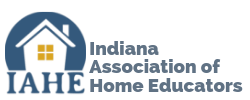
What is the relationship between public schools and home schools in Indiana?
All references to Indiana Code are found in the Compulsory School Attendance law: IC 20-33-2.Public Education & Homeschools: Frequently Asked Questions
WHAT AUTHORIZATION IS NEEDED TO MAKE A HOME SCHOOL LEGAL IN INDIANA?
Home schools are nonpublic, non-accredited schools. As such, the parent, not the state, legally establishes the school. No state or public school “permission” is required.
WHAT DOES THE LAW REQUIRE OF HOME EDUCATORS?
They must teach a minimum of 180 days per year. They choose the days on which classes will be held and must keep attendance records; however, the law doesn’t specify form or content requirements for these records. These are the only records that must be provided to local superintendents upon their request.
The compulsory school attendance law requires private school educators to report the number of students educated at each grade level upon request of the state superintendent.
CAN SCHOOLS PREVENT PARENTS, WHO HAVE NOT YET REPORTED THEIR ENROLLMENT TO THE STATE, FROM WITHDRAWING THEIR CHILDREN FOR HOME SCHOOL? HOW DOES THE PUBLIC SCHOOL VERIFY ENROLLMENT IN THE HOME SCHOOL?
Parents have the right to choose where their children go to school. This includes a home school. Public schools are not authorized to prohibit custodial parents or legal guardians from making such a transfer at any time.
The school should, on behalf of the State Superintendent, request that parents and guardians report their schools’ grade-level enrollment to the IDOE, and provide the appropriate state form or telephone number at the time of the transfer. It is then the parents’ responsibility to comply with the law. The public school has no duty to verify compliance.
As with any other transfer, the public school’s responsibility ends when the administration of the child’s new school (in this case, the parent) verifies enrollment, either verbally or in writing.
ARE PUBLIC SCHOOLS RESPONSIBLE FOR REQUIRING HOME EDUCATING PARENTS TO USE AN APPROVED CURRICULUM, OR FOR MONITORING FOR EQUIVALENCY OF INSTRUCTION?
No. Upon re-entry, the school can assess the results of the educational process and grant credit or not. Under Indiana Code, home schools are “not bound by any requirements…with regard to curriculum or the content of educational programs offered by the [public] school.”
There is no statutory definition of equivalency of instruction, nor is there any legal authority for public schools to monitor, or impose curricular requirements upon, nonpublic schools.
CAN THE SCHOOL REFUSE T0 RE-ENROLL A CHILD?
No. With the exception of expulsions, no public school may refuse a student living in its district. IC 20-33-2-6 states:
IC 20-33-2-6 Students required to attend
Sec. 6. A student is bound by the requirements of this chapter from the earlier of the date on which the student officially enrolls in a school or, except as provided in section 8 of this chapter, the beginning of the fall school term for the school year in which the student becomes seven (7) years of age until the date on which the student:
(1) graduates;
(2) becomes eighteen (18) years of age; or
(3) becomes sixteen (16) years of age but is less than eighteen (18) years of age and the requirements under section 9 of this chapter concerning an exit interview are met enabling the student to withdraw from school before graduation;
whichever occurs first.
[Pre-2005 Elementary and Secondary Education Recodification Citation: 20-8.1-3-17(b), (c).] As added by P.L.1-2005, SEC.17. Amended by P.L.242-2005, SEC.17.
*Please note, part 3 only refers to dropouts.
HOW DO WE ACCOUNT FOR THE HOME-EDUCATED CHILD WHO LEAVES [AND RETURNS]? WHAT IF THE PARENT NEVER REPORTED ENROLLMENT DATA OR RECEIVED A SCHOOL NUMBER FROM THE IDOE?
Home-educated children are transfer students, regardless of whether their parents’ reported the home school’s enrollment. Upon re-entry, the public school must enroll the child and begin instruction immediately. Under no circumstances should the resumption of the child’s education be delayed once he or she is returned to the public school.
WHERE SHOULD HOME-EDUCATED CHILDREN BE PLACED AFTER THEY ARE RETURNED TO ELEMENTARY OR MIDDLE SCHOOL?
One possibility is to place these children with their age-appropriate peers on a probationary basis. This minimizes conflicts with parents while giving the school time to assess a child’s knowledge.
CAN PUBLIC SCHOOLS GRANT CREDIT FOR HIGH SCHOOL WORK PERFORMED IN A HOME SCHOOL?
Indiana law gives public schools the discretion of whether or not to accept work completed through home education. Families of high school students should check their local school district’s policies if they do not intend to homeschool through graduation.
When a homeschooled student returns to public school, the school should assess what children have learned, not where they learned it. The Indiana Department of Education recommends objective testing and/or consideration of documentation presented by parents as soon as possible upon re-entry in order to determine whether any credit will be granted. While it should not be awarded unless earned, the public school may award credit if the student can demonstrate the knowledge required to pass a course.
Remember, home schools are nonpublic, non-accredited schools, not bound by the regulations that govern curricula, instructional time, or teacher licensure and certification in public schools.
Public schools may give credit for work mastered in such a school without violating state statute, State Board rules, or of jeopardizing their accreditation status.
WHO DECIDES TO GRANT CREDIT?
The public school corporation has the right to determine placement and what, if any, credit will be granted to a general education student. While the objective assessment described above is preferable, it is not required by law.
The Department recommends that schools develop a process to govern the granting of credit for work done in any non-public, non-accredited setting; that it be approved by the superintendent and the local school board; and that it be applied uniformly.
Please note that the placement of special needs children is determined by case conference committees.
CAN HOME-EDUCATED CHILDREN RETURN FOR THE 12TH GRADE AND GRADUATE?
Theoretically, yes, if the public school determines that the combination of credits awarded for work done in home school and credits earned in an accredited private or public school meets state graduation requirements and if the student passes the ISTEP+ graduation exam (or qualifies under one of the waiver alternatives) after re-enrolling in the public school.
Remember: upon re-entry, the public school has the authority to grant or deny credit for work done in home school.
CAN HOME-EDUCATED STUDENTS TAKE PART IN PUBLIC SCHOOL EDUCATIONAL ACTIVITIES?
Indiana Code allows participation with the approval of the superintendent or school board. They can come to the agreed-upon classes and return to their home school for the rest of the day. They can be counted in attendance, but only if enrolled for at least one class each day.
For example, a student could be enrolled for a course [e.g., computer keyboarding] with the superintendent’s permission, and the student would be counted in attendance in the public school. However if a student only participates in a class, but is not enrolled, the student would not be counted in attendance.
If the student is enrolled in and attending the public school by the annual ADM count in September, the public school will receive funding from the state based on the number of classes taken.
It is up to the public school to decide whether or not to allow a privately educated child to participate in non-educational activities (e.g., dance clubs, etc.) Participation in high school level sports is subject to approval by the public school, and to the home educator’s willingness to enroll the child in public school for one class per day and otherwise comply with the bylaws of the IHSAA. For specifics, contact IHSAA at 317-846-6601.
The IHSAA changed its rules regarding home-educated students in 2013. See the IHSAA website for details.
Please note that dual enrollment or attendance in the public school does not subject the home school to any additional regulation by the State or local public schools.
CAN PARENTS ALREADY IN TROUBLE FOR EVENTS OCCURRING IN THE PUBLIC SCHOOL (I.E., TRUANCY OR EDUCATIONAL NEGLECT) AVOID LEGAL ACTION BY TRANSFERRING THEIR CHILDREN TO HOME SCHOOL?
Not necessarily. While public schools have no jurisdiction over children once they are transferred to a nonpublic school, the transfer does not “clean the slate” of past bad behavior. Prosecutors may pursue charges brought prior to withdrawal if they believe it is in a child’s best interest.
HOW DO WE KNOW THAT A CHILD IS BEING EDUCATED?
The home-educating parent has assumed legal responsibility for the child’s education and will be held accountable should minimum statutory requirements not be met. The law does not allow public education to supervise nonpublic schooling through testing, inspection, or curriculum approval.
Persons with specific reasons to believe a parent is unable or unwilling to educate his or her school-aged child are obligated to report this to the county child protective services office (IC 31-33-5-2). However, the solitary facts that a parent chooses to home educate, and /or fails to notify the State of his or her home school’s grade-level enrollment, are not, in and of themselves, cause for such a report, nor do they constitute educational neglect in and of themselves.
Anyone who intentionally files a fraudulent report may be subject to prosecution for malicious reporting under Indiana law.
DOES THE SCHOOL STILL RECEIVE MY TAX MONEY WHEN I WITHDRAW MY STUDENT?
Tax revenue for education is collected by the state of Indiana, whether you have any children, school-age or not. The state then distributes money to the schools based on the number of students enrolled.
The tuition support formula’s fundamental building block is student enrollment. The official enrollment count—often referred to as Average Daily Membership (or ADM count)—relies upon two count dates (fall and spring). The official ADM counts are used to determine how much basic tuition support funding (i.e., the Foundation Grant plus Complexity Grant) each school corporation will receive throughout the school year, which aligns with the July-June state fiscal year. Public schools receive their first monthly tuition support distribution for a given school year in July. The July distribution is based on ADM estimates that schools provide to the Indiana Department of Education (DOE) by April 1 of the prior year. Once the September ADM count is certified, DOE reconciles the tuition support distributions for the first six months of the fiscal year (July through December) to match actual enrollment. Once the second count date is certified, DOE reconciles the tuition support distributions for the remaining six months.
